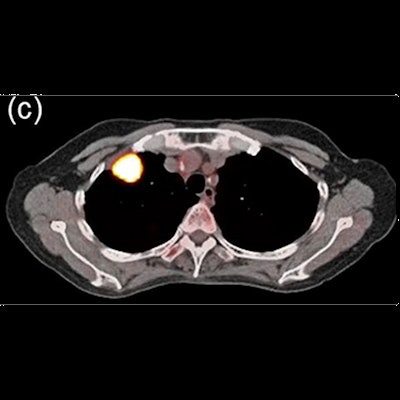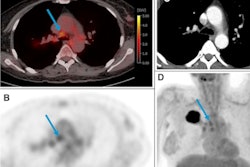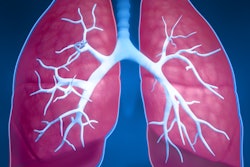
PET imaging can identify potential tumor biomarkers tied to genetic mutations involved in lung cancer, according to a study published April 25 in Scientific Reports.
A group led by researchers at Kagawa University in Kagawa, Japan, investigated the relationship between F-18 FDG-PET tumor texture features and epidermal growth factor receptor (EGFR) mutation status in newly diagnosed patients with lung adenocarcinoma. They found five PET tumor features correlated significantly with EGFR status, and they suggest these biomarkers can help diagnose the disease, wrote first authors Dr. Mariko Ishimura and Dr. Takashi Norikane, PhD, and colleagues.
"Although biopsy is the gold standard for gene mutation diagnosis, it is difficult to obtain satisfactory specimens due to various factors," the group noted. "Consequently, it is important to develop simple and noninvasive methods to identify the EGFR mutation status."
Identifying the EGFR mutation status is important for the optimal treatment of lung cancer patients with these abnormalities, as EGFR-targeted tyrosine kinase inhibitors have proven to be among the most effective treatments, the researchers explained.
Although biopsy is the go-to method for diagnosing gene mutations, it may not account for tumor heterogeneity (that is, different regions of the tumor may have different genetic mutations). Few published studies focusing on whether tumor heterogeneity from PET images can identify EGFR mutation status exist, they added.
The study authors analyzed data from 66 patients (41 men, 25 women; mean age, 73) with newly diagnosed lung cancer who underwent pretreatment FDG-PET/CT and EGFR mutation testing between August 2014 and November 2020. The group divided patients into mutated EGFR and wild-type EGFR groups; they calculated maximum standardized uptake value (SUVmax) and 31 texture features for the primary tumor from PET images and compared them between the two groups.
![Representative images of a 69-year-old woman with mutated EGFR lung adenocarcinoma. (a) CT image showing a mass in the right upper lobe. (b) FDG-PET and (c) PET/CT fusion images showing intense uptake in the tumor (maximum standardized uptake value [SUVmax] = 16.8, correlation = 0.1, gray-level nonuniformity for run [GLNUr] = 6.86, run length nonuniformity [RLNU] = 136.6, coarseness = 0.033, long-zone high gray-level emphasis [LZHGE] = 5223, and gray-level nonuniformity for zone [GLNUz] = 4.25). Image and caption courtesy of Scientific Reports through CC BY 4.0.](https://img.auntminnie.com/files/base/smg/all/image/2023/05/am.2023_05_02_20_33_9347_2023_05_03_PET_EGFR.png?auto=format%2Ccompress&fit=max&q=70&w=400) Representative images of a 69-year-old woman with mutated EGFR lung adenocarcinoma. (a) CT image showing a mass in the right upper lobe. (b) FDG-PET and (c) PET/CT fusion images showing intense uptake in the tumor (maximum standardized uptake value [SUVmax] = 16.8, correlation = 0.1, gray-level nonuniformity for run [GLNUr] = 6.86, run length nonuniformity [RLNU] = 136.6, coarseness = 0.033, long-zone high gray-level emphasis [LZHGE] = 5223, and gray-level nonuniformity for zone [GLNUz] = 4.25). Image and caption courtesy of Scientific Reports through CC BY 4.0.
Representative images of a 69-year-old woman with mutated EGFR lung adenocarcinoma. (a) CT image showing a mass in the right upper lobe. (b) FDG-PET and (c) PET/CT fusion images showing intense uptake in the tumor (maximum standardized uptake value [SUVmax] = 16.8, correlation = 0.1, gray-level nonuniformity for run [GLNUr] = 6.86, run length nonuniformity [RLNU] = 136.6, coarseness = 0.033, long-zone high gray-level emphasis [LZHGE] = 5223, and gray-level nonuniformity for zone [GLNUz] = 4.25). Image and caption courtesy of Scientific Reports through CC BY 4.0.Out of the 66 patients, 22 had mutated EGFR and 44 had wild-type EGFR. The SUVmax did not significantly differ between the two groups.
However, among the 31 texture features, five showed statistically significant differences between the groups. Specifically, these included correlation (p = 0.003), gray-level nonuniformity for run (p = 0.042), run length nonuniformity (p = 0.02), coarseness (p = 0.006), and gray-level nonuniformity for zone (p = 0.04), according to the findings.
"Based on the preliminary results of this study in a small patient population, FDG-PET texture indices may be potential imaging biomarkers for the EGFR mutation status," the group noted.
The team urged future research, since many PET tumor texture features have been reported as potentially useful in previous work but there remains no clear indication as to which one should be used.
"Further prospective studies with bigger sample sizes will help to clarify the utility of FDG-PET as an alternative indicator of EGFR mutation status when tissue samples are not available," the researchers concluded.





















